International Journal of Image, Graphics and Signal Processing @ijigsp
Статьи журнала - International Journal of Image, Graphics and Signal Processing
Все статьи: 1157
Multiple Objects Tracking Using CAMShift Algorithm and Implementation of Trip Wire
Статья научная
In this paper we represent Security application which is developed using concepts of Video Analytics. User can draw Trip wire on video stream with help of Mouse Callback events. Using this application user can restrict any area of total video scene. Direction selection for tripping is also a choice of a user. If any undesired moving object cross this drawn trip wire then motion of this moving object is getting detected and also tracked. If object crosses trip wire in the same direction as that of user selected then Alarm Indication will appear on that moving object. OpenCV library functions are used for motion detection and motion tracking. CAMShift algorithm is implemented for tracking. An experimental result shows Motion detection, Motion Tracking and drawn trip wire on video.
Бесплатно
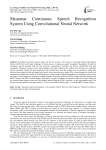
Myanmar Continuous Speech Recognition System Using Convolutional Neural Network
Статья научная
Translating the human speech signal into the text words is also known as Automatic Speech Recognition System (ASR) that is still many challenges in the processes of continuous speech recognition. Recognition System for Continuous speech develops with the four processes: segmentation, extraction the feature, classification and then recognition. Nowadays, because of the various changes of weather condition, the weather news becomes very important part for everybody. Mostly, the deaf people can’t hear weather news when the weather news is broadcast by using radio and television channel but the deaf people also need to know about that news report. This system designed to classify and recognize the weather news words as the Myanmar texts on the sounds of Myanmar weather news reporting. In this system, two types of input features are used based on Mel Frequency Cepstral Coefficient (MFCC) feature extraction method such MFCC features and MFCC features images. Then these two types of features are trained to build the acoustic model and are classified these features using the Convolutional Neural Network (CNN) classifiers. As the experimental result, The Word Error Rate (WER) of this entire system is 18.75% on the MFCC features and 11.2% on the MFCC features images.
Бесплатно
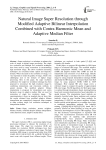
Статья научная
Super resolution is a technique to enhance the scale of image in digital image processing. The single low resolution and multiple low resolution techniques have been used by many researchers in reconstructing high resolution image. The above resolution increasing techniques are researched under spatial and frequency domain. When increased in the resolution of image, it is very important to retain the quality of image, which is the challenging task in the domain of digital image processing. Here in this paper, the super resolution architecture for single low resolution technique has been proposed to reconstruct the high resolution image by combining interpolation and restoration methods in spatial domain. The modified adaptive bilinear interpolation is proposed for interpolation and contra harmonic mean & adaptive median filter are used for restoration of single low resolution image. The experimentation is done on standard data set show that, the results obtained from modified adaptive bilinear interpolation are competitively improved when compare to other existing single low resolution techniques in interpolation domain.
Бесплатно

Neural Network Synchronous Binary Counter Using Hybrid Algorithm Training
Статья научная
Information processing using Neural Network Counter can result in faster and accurate computation of data due to their parallel processing, learning and adaptability to various environments. In this paper, a novel 4-Bit Negative Edge Triggered Binary Synchronous Up/Down Counter using Artificial Neural Networks trained with hybrid algorithms is proposed. The Counter was built solely using logic gates and flip flops, and then they are trained using different evolutionary algorithms, with a multi objective fitness function using the back propagation learning. Thus, the device is less prone to error with a very fast convergence rate. The simulation results of proposed hybrid algorithms are compared in terms of network weights, bit-value, percentage error and variance with respect to theoretical outputs which show that the proposed counter has values close to the theoretical outputs.
Бесплатно
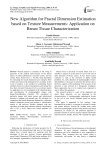
Статья научная
Fractal analysis is currently in full swing in particular in the medical field because of the fractal nature of natural phenomena (vascular system, nervous system, bones, breast tissue ...). For this, many algorithms for estimating the fractal dimension have emerged. Most of them are based on the principle of box counting. In this work we propose a new method for calculating fractal attributes based on contrast homogeneity and energy that have been extracted from gray level co-occurrence matrix. As application we are investigated in the characterization and classification of mammographic images with SuportVectorMachine classifier. We considered in particular images with tumor masses and architectural disorder to compare with normal ones. We calculate, for comparison the fractal dimension obtained by a reference method (triangular prism) and perform a classification similar to the previous. Results obtained with new algorithm are better than reference method (classification rate is 0.91 vs 0.65). Hence new fractal attributes are relevant.
Бесплатно
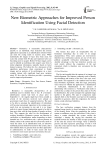
New Biometric Approaches for Improved Person Identification Using Facial Detection
Статья научная
Biometrics is measurable characteristics specific to an individual. Face detection has diverse applications especially as an identification solution which can meet the crying needs in security areas. While traditionally 2D images of faces have been used, 3D scans that contain both 3D data and registered color are becoming easier to acquire. Before 3D face images can be used to identify an individual, they require some form of initial alignment information, typically based on facial feature locations. We follow this by a discussion of the algorithms performance when constrained to frontal images and an analysis of its performance on a more complex dataset with significant head pose variation using 3D face data for detection provides a promising route to improved performance.
Бесплатно
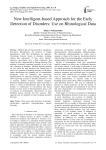
New Intelligent-based Approach for the Early Detection of Disorders: Use on Rhinological Data
Статья научная
Medical data are characterized by complexity, inaccuracy, heterogeneity, the presence of hidden dependencies, often their distributions are unknown. Correlations between factors of disorders, including clinical data, parameters of time series, patient’s subjective assessments have a high complexity that cannot be fully comprehended by humans anymore. This problem is extremely important especially in case of the early detection of disorders. Machine learning methods are very useful for such detection task. Special area of interest is a problem of breathing disorders. In the paper, author demonstrates the potential use of computational intelligence tools for rhinologic data processing. Implementation of supervised learning techniques will allow improving accuracy of disorders detection as well as decrease medical insurance company expenses. Proposed intelligent-based approach makes it possible to process a variety of heterogeneous data in the medical domain. A combination of conventional and fractal features for time series of rhinomanometric data as well as inclusion of hydrodynamic characteristics of nasal breathing process provides the best accuracy. Such approach may be modified for other breathing disorders detection.
Бесплатно
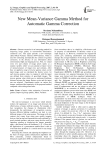
New Mean-Variance Gamma Method for Automatic Gamma Correction
Статья научная
Gamma correction is an interesting method for improving image quality in uncontrolled illumination conditions case. This paper presents a new technique called Mean-Variance Gamma (MV-Gamma), which is used for estimating automatically the amount of gamma correction, in the absence of any information about environmental light and imaging device. First, we valued every row and column of image pixels matrix as a random variable, where we can calculate a feature vector of means/variances of image rows and columns. After that, we applied a range of inverse gamma values on the input image, and we calculated the feature vector, for each inverse gamma value, to compare it with the target one defined from statistics of good-light images. The inverse gamma value which gave a minimum Euclidean distance between the image feature vector and the target one was selected. Experiments results, on various test images, confirmed the superiority of the proposed method compared with existing tested ones.
Бесплатно
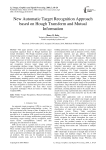
New automatic target recognition approach based on Hough transform and mutual information
Статья научная
This paper presents a new automatic target recognition approach based on Hough transform and mutual information. The Hough transform groups the extracted edge points in edged images to an appropriate set of lines which helps in features extraction and matching processes in both of target and stored database images. This gives an initial indication about realization and recognition between target image and its corresponding database image. Mutual information is used to emphasize the recognition of the target image and its verification with its corresponding database image. The proposed recognition approach passed through five stages which are: edge detection by Sobel edge detector, thinning as a morphological operation, Hough transformation, matching process and finally measuring the mutual information between target and the available database images. The experimental results proved that, the target recognition is realized and gives more accurate and successful recognition rate than other recent recognition techniques which are based on stable edge weighted HOG.
Бесплатно
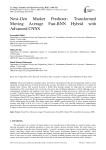
Next-Gen Market Predictor: Transformed Moving Average Fast-RNN Hybrid with Advanced CNNS
Статья научная
Stock price prediction anticipates future stock prices using historical data and computational models to assist and guide investing decisions. In financial forecasting, accuracy and efficacy in stock price prediction are essential for making better choices. This research describes a hybrid deep learning strategy for improving the extraction and interpretation of the crucial details from stock price time series data. Traditional approaches confront challenges such as computational complexity and nonlinear stock prices. The suggested method pre-processes stock data with Moving Average Z-Transformation, which emphasises long-term trends and reduces fluctuations in the short term. It combines a Transformed Moving Average Fast-RNN Hybrid with Advanced CNNs to create an efficient computational framework. The Enhanced Deep-CNN layer comprises convolutional layers, batch normalisation, leaky ReLU activations, dropout, max pooling and a dense layer. The performance of the model is quantified using metrics including Mean Absolute Error (MAE), Mean Square Error (MSE), Root Mean Square Error (RMSE), and R-squared (R2). It shows superior prediction accuracy with MAEs of 0.28, 0.15, 0.34, 0.17, and 0.13 for Kotak, ICICI, Axis, and SBI, respectively, outperforming previous models. These measurements provide detailed information about the model's predictive skills, proving its ability to improve stock price forecast accuracy significantly.
Бесплатно
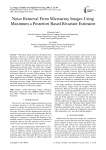
Noise Removal From Microarray Images Using Maximum a Posteriori Based Bivariate Estimator
Статья научная
Microarray Image contains information about thousands of genes in an organism and these images are affected by several types of noises. They affect the circular edges of spots and thus degrade the image quality. Hence noise removal is the first step of cDNA microarray image analysis for obtaining gene ex-pression level and identifying the infected cells. The Dual Tree Complex Wavelet Transform (DT-CWT) is preferred for denoising microarray images due to its properties like improved directional selectivity and near shift-invariance. In this paper, bivariate estimators namely Linear Minimum Mean Squared Error (LMMSE) and Maximum A Posteriori (MAP) derived by applying DT-CWT are used for denoising microarray images. Experimental results show that MAP based denoising method outperforms existing denoising techniques for microarray images.
Бесплатно
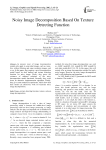
Noisy Image Decomposition Based On Texture Detecting Function
Статья научная
At present, most of image decomposition models only apply to some ideal images, such as, noise-free, without blurring and super resolution images, and so on. In this paper, they propose a novel decomposition model based on dual method and texture detecting function for noisy image. Firstly, they prove the existence of minimal solutions of the noisy decomposition model functional. Secondly, they write down an alterative implementation algorithm. Finally, they give some numerical experiments, which show that their model can effectively work for Gaussian noisy image decomposition.
Бесплатно
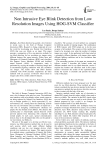
Non Intrusive Eye Blink Detection from Low Resolution Images Using HOG-SVM Classifier
Статья научная
Eye blink detection has gained a lot of interest in recent years in the field of Human Computer Interaction (HCI). Research is being conducted all over the world for developing new Natural User Interfaces (NUI) that uses eye blinks as an input. This paper presents a comparison of five non-intrusive methods for eye blink detection for low resolution eye images using different features like mean intensity, Fisher faces and Histogram of Oriented Gradients (HOG) and classifiers like Support Vector Machines (SVM) and Artificial neural network (ANN). A comparative study is performed by varying the number of training images and in uncontrolled lighting conditions with low resolution eye images. The results show that HOG features combined with SVM classifier outperforms all other methods with an accuracy of 85.62% when tested on images taken from a totally unknown dataset.
Бесплатно
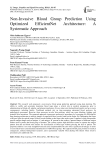
Non-Invasive Blood Group Prediction Using Optimized EfficientNet Architecture: A Systematic Approach
Статья научная
This research work proposed a non-invasive blood group prediction approach using deep learning. The ability to swiftly and accurately determine blood types plays a critical role in medical emergencies prior to administering red blood cell, platelet, and plasma transfusions. Even a minor error during blood transfer can have severe consequences, including fatality. Traditional methods rely on time-consuming automated blood analyzers for pathological assessment. However, these processes involve skin pricking, which can cause bleeding, fainting, and potential skin lacerations. The proposed approach circumvents noninvasive procedures by leveraging rich EfficientNet deep learning architecture to analyze images of superficial blood vessels found on the finger. By illuminating the finger with laser light, the optical image of blood vessels hidden on the finger skin surface area is captured, which incorporates specific antigen shapes such as antigen ‘A’ and antigen ‘B’ present on the surface. Captured shapes of different antigen further used to predict the blood group of humans. The system requires high-definition camera to capture the antigen pattern from the red blood cells surface for classification of blood type without piercing the skin of patient. The proposed solution is not only straightforward and easily implementable but also offers significant advantages in terms of cost-effectiveness and immediate identification of ABO blood groups. This approach holds great promise for medical emergencies, military battleground scenarios, and is particularly valuable when dealing with infants where invasive procedures pose additional risks.
Бесплатно
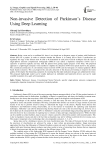
Non-invasive Detection of Parkinson's Disease Using Deep Learning
Статья научная
Being a near end to a confident life, there is no simple test to diagnose stages of patients with Parkinson's disease (PD) for a patient. In order to estimate whether the disease is in control and to check if medications are regulated, the stage of the disease must be able to be determined at each point. Clinical techniques like the specific single-photon emission computerized tomography (SPECT) scan called a dopamine transporter (DAT) scan is expensive to perform regularly and may limit the patient from getting regular progress of his body. The proposed approach is a lightweight computer vision method to simplify the detection of PD from spirals drawn by the patients. The customized architecture of convolutional neural network (CNN) and the histogram of oriented gradients (HoG) based feature extraction. This can progressively aid early detection of the disease provisioning to improve the future quality of life despite the threatening symptoms by ensuring that the right medication dosages are administered in time. The proposed lightweight model can be readily deployed on embedded and hand-held devices and can be made available to patients for a quick self-examination.
Бесплатно

Noninvasive Hemoglobin Monitoring Device for Disease Detection
Статья научная
A noninvasive blood hemoglobin monitoring device was designed specifically for monitoring anemia and polycythemia. Invasive techniques, which are painful and expensive, are commonly used to estimate blood hemoglobin concentrations. This paper presents a noninvasive method for monitoring blood hemoglobin values. A photodiode and a near-infrared (NIR) LED with a wavelength of 940 nm were used to construct a finger probe. At 940 nm wavelength shows distinct variation between oxygenated and deoxygenated hemoglobin and single-wavelength systems significantly reduce hardware complexity, cost, power consumption, and size. Use a continuous-wave NIR LED light through the finger to check the sensitivity of different hemoglobin concentrations. A total of 100 patients participated in our proposed device for evaluating noninvasive hemoglobin concentration. These participants collected both invasive and noninvasive hemoglobin concentration values. The correlation coefficient between the predicted (noninvasive) hemoglobin value and the reference (invasive) hemoglobin value was 0.9496, with a normalized root mean squared error (NRMSE) of 0.6504 and a mean absolute percentage error (MAPE) of 0.0505. The noninvasive blood hemoglobin level was classified using the k-nearest neighbour (kNN) classifier, and the proposed device accuracy was calculated at 90%. The Bland-Altman methodology evaluated differences between invasive and noninvasive blood hemoglobin concentrations. The absolute mean difference was 0.1124 (95% confidence interval [CI] -0.01535 to 0.2401), with an upper agreement limit of 1.374 (95% CI [1.153 - 1.595]) and a lower agreement limit of -1.149 (95% CI [-1.371 - 0.9282]).
Бесплатно
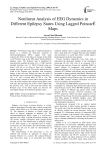
Nonlinear analysis of EEG dynamics in different epilepsy states using lagged Poincaré maps
Статья научная
The Poincaré map and its width and length are known as a criterion for short-term variations of electroencephalogram (EEG) signals. This study evaluates the effect of time delay on changes in the width of the Poincaré map in the EEG signal during different epilepsy states. The Poincaré map is quantified by measuring the standard deviation over (SD1) and the standard deviation over (SD2). Poincaré maps are drawn with one to six delay in three sets, including normal, inter-ictal, and ictal. The results indicate that the width of the Poincaré map increases with increasing latency in the ictal state. During ictal state, the width of the Poincaré map is achieved by applying a unit delay of 102 ± 8.7 and a six-unit delay of 305 ± 13.6. The Poincaré map is shifted to lower values during ictal state. Also, the results indicate that with increasing delay in the ictal state, the increasing rate of SD1 value is higher than the previous ones, such as inter-ictal and normal. The Poincaré map of the EEG signal can discover the meaningful changes in the different epilepsy states.
Бесплатно
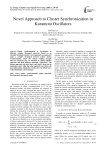
Novel Approach to Cluster Synchronization in Kuramoto Oscillators
Статья научная
Cluster synchronization is investigated in different complex dynamical networks. Based on an extended Kuramoto model, a novel approach is proposed to make a complex dynamical network achieve cluster synchronization, where the critical coupling strength between connected may be obtained by global adaptive approach and local adaptive approach, respectively. The former approach only need know each node’s state and its destination state; while the latter approach need know the local information. Simulation results show the effectiveness of the distributed control strategy.
Бесплатно
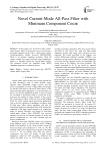
Novel Current-Mode All-Pass Filter with Minimum Component Count
Статья научная
In this paper, two novel first order current-mode all-pass filters are proposed using a resistor and a grounded capacitor along with a multi-output dual-X second-generation current conveyor (MO-DXCCII). There is no element matching restriction. Both the circuits exhibit low input and high output impedance, which is a desirable feature for current-mode circuits. The proposed circuits are simulated using SPICE simulation program to confirm the theory.
Бесплатно
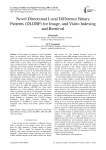
Статья научная
In this paper, we propose a novel algorithm based on directional local difference binary patterns useful for content based image indexing and retrieval. The popular and successful method local binary patterns (LBP) codify a pixel, based on the neighborhood gray values around the pixel. Another flavor of LBP is, center symmetric local binary patterns (CS-LBP), which is the base method for our proposed novel algorithm. The proposed method is based on the directional difference between neighboring pixels. The four directional local difference binary patterns (DLDBP) in 0o, 45o, 90o, and 135o directions are proposed. Then, we apply our method on benchmark image database Corel-1k. The proposed DLDBP (Directional Local Difference Binary Patterns) can also be used to represent a video, using a key frame in the video. We apply the proposed directional local difference binary patterns (DLDBP) key frame based algorithm, on a video database, which consists of ten videos of airplane, ten videos of sailing boat , ten videos of car, and ten videos are of war tank. The performance of proposed DLDBP (Directional Local Difference Binary Patterns) is compared with CS-LBP (Central Symmetric Local Binary Patterns) method. The performance of DLDBP key frame based method is compared with volume local binary patterns (VLBP) method.
Бесплатно

